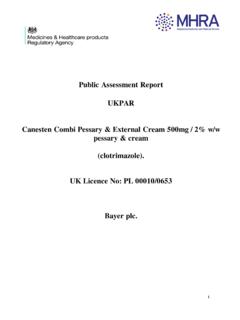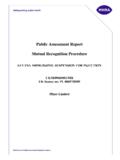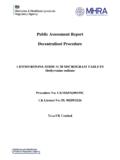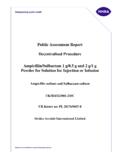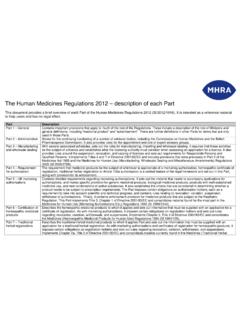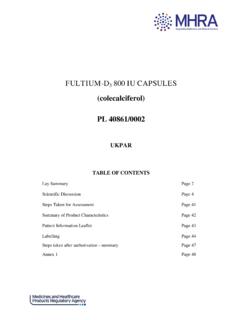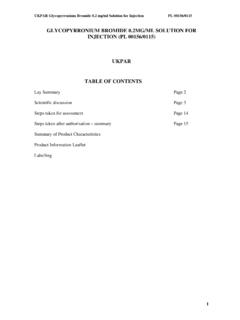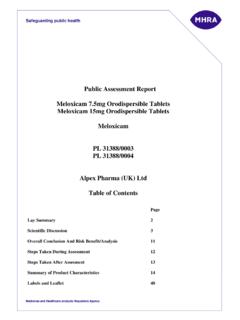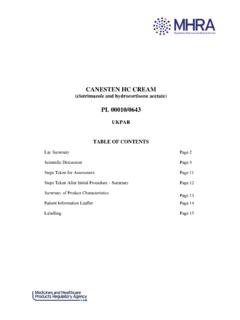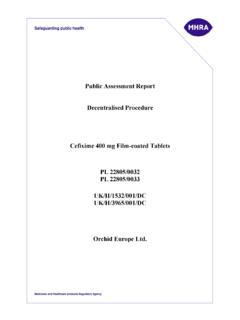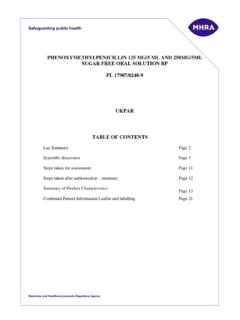Transcription of Public Assessment Report Decentralised Procedure - GOV.UK
1 Public Assessment Report Decentralised Procedure CO-AMOXICLAV 250mg /125MG FILM-COATED TABLETS CO-AMOXICLAV 500MG/125MG FILM-COATED TABLETS Procedure No: UK/H/3244/001-2/DC UK Licence No: PL 25298/0007-8 BROWN AND BURK UK LIMITED PAR Co-Amoxiclav 250mg /125 and 500mg/125mg Film-Coated Tablets UK/H/3244/001-2/DC 2 LAY SUMMARY On 23 December 2011, the MHRA granted Brown and Burk UK Limited Marketing Authorisations (licences) for the medicinal products Co-amoxiclav 250mg /125mg and 500mg/125mg Film-coated Tablets (PL 25298/0007-8). These are prescription-only medicines, containing two different medicines called amoxicillin and clavulanic acid, and are used to treat the following infections in adults and children: 250mg /125mg film-coated tablets: Sinus infections Urinary tract infections Skin infections Dental infections 500mg/125mg film-coated tablets: Middle ear and sinus infections Respiratory tract infections Urinary tract infections Skin and soft tissue infections, including dental infections Bone and joint infections amoxicillin belongs to a group of medicines called penicillins that sometimes can be stopped from working (made inactive).
2 The other active component, clavulanic acid, stops this from happening. No new or unexpected safety concerns have arisen from these applications and it was, therefore, concluded that the benefits of taking Co-amoxiclav 250mg /125mg and 500mg/125mg Film-coated Tablets outweigh the risks, hence Marketing Authorisations have been granted. PAR Co-Amoxiclav 250mg /125 and 500mg/125mg Film-Coated Tablets UK/H/3244/001-2/DC 3 TABLE OF CONTENTS Module 1: Information about initial Procedure Page 3 Module 2: Summary of Product Characteristics Page 4 Module 3: Product Information Leaflets Page 22 Module 4: Labelling Page 24 Module 5: Scientific Discussion Page 28 1 Introduction 2 Quality aspects 3 Non-clinical aspects 4 Clinical aspects 5 Overall conclusions Module 6 Steps taken after initial Procedure PAR Co-Amoxiclav 250mg /125 and 500mg/125mg Film-Coated Tablets UK/H/3244/001-2/DC 4 Module 1 Product Name Co-Amoxiclav 250mg /125mg Film-Coated Tablets Co-Amoxiclav 500mg/125mg Film-Coated Tablets Type of Application Generic, Article Active Substances amoxicillin trihydrate and potassium clavulanate Form Film-coated tablet Strength 250mg or 500mg amoxicillin (as amoxicillin trihydrate) and 125mg clavulanic acid (as potassium clavulanate) MA Holder Brown & Burk UK Ltd, 5 Marryat Close, Hounslow West, Middlesex, TW4 5DQ, United Kingdom Reference Member State (RMS)
3 UK CMS Ireland, Sweden Procedure Number UK/H/3244/001-2/DC Timetable Day 210 1 December 2011 PAR Co-Amoxiclav 250mg /125 and 500mg/125mg Film-Coated Tablets UK/H/3244/001-2/DC 5 Module 2 Summary of Product Characteristics 1 NAME OF THE MEDICINAL PRODUCT Co-amoxiclav 250mg /125mg Film-coated Tablets 2 QUALITATIVE AND QUANTITATIVE COMPOSITION Each film-coated tablet contains 250mg amoxicillin as amoxicillin trihydrate and 125mg of clavulanic acid as potassium clavulanate diluted For a full list of excipients see section 3 PHARMACEUTICAL FORM Film-coated tablet. White colored capsule shaped film coated tablet debossed with I 05 on one side and plain on other side. Tablet length = 4 CLINICAL PARTICULARS Therapeutic indications Co-amoxiclav is indicated for the treatment of the following infections in adults and children (see sections , and ).
4 Acute bacterial sinusitis (adequately diagnosed) Cystitis Pyelonephritis Cellulitis Animal bites Severe dental abscess with spreading cellulitis. Consideration should be given to official guidance on the appropriate use of antibacterial agents. Posology and method of administration Doses are expressed throughout in terms of amoxicillin /clavulanic acid content except when doses are stated in terms of an individual component. The dose of Co-amoxiclav that is selected to treat an individual infection should take into account: The expected pathogens and their likely susceptibility to antibacterial agents (see section ) The severity and the site of the infection The age, weight and renal function of the patient as shown below. The use of alternative presentations of Co-amoxiclav ( those that provide higher doses of amoxicillin and/or different ratios of amoxicillin to clavulanic acid) should be considered as necessary (see sections and ).
5 For adults and children 40 kg, this formulation of Co-amoxiclav provides a total daily dose of 750 mg amoxicillin /375 mg clavulanic acid, when administered as recommended below. If it is considered that a higher daily dose of amoxicillin is required, it is recommended that another preparation of Co-amoxiclav is selected in order to avoid administration of unnecessarily high daily doses of clavulanic acid (see sections and ). Treatment should not be extended beyond 14 days without review. Adults and children 40 kg One 250 mg/125 mg tablet taken three times a day. Children < 40 kg Co-amoxiclav 250 mg/125 mg film-coated tablets are not recommended in children < 40 kg. Elderly No dose adjustment is considered necessary. PAR Co-Amoxiclav 250mg /125 and 500mg/125mg Film-Coated Tablets UK/H/3244/001-2/DC 6 Renal impairment Dose adjustments are based on the maximum recommended level of amoxicillin . No adjustment in dose is required in patients with creatinine clearance (CrCl) greater than 30 ml/min.
6 Adults and children 40 kg CrCl: 10-30 ml/min 250 mg/125 mg twice daily CrCl < 10 ml /min 250 mg/125 mg once daily Haemodialysis Two doses of 250 mg/125 mg every 24 hours, plus two doses of 250 mg/125 mg during dialysis, to be repeated at the end of dialysis (as serum concentrations of both amoxicillin and clavulanic acid are decreased) Children < 40 kg In children < 40 kg with creatinine clearance less than 30 ml/min, the use of Co-amoxiclav presentations with an amoxicillin to clavulanic acid ratio of 2:1 is not recommended, as no dose adjustments are available. In such patients, Co-amoxiclav formulations with an amoxicillin to clavulanic acid ratio of 4:1 are recommended. Hepatic impairment Dose with caution and monitor hepatic function at regular intervals (see sections and ). Method of administration Co-amoxiclav is for oral use. Administer at the start of a meal to minimise potential gastrointestinal intolerance and optimise absorption of amoxicillin /clavulanic acid.
7 Contraindications Hypersensitivity to the active substances, to any of the penicillins or to any of the excipients. History of a severe immediate hypersensitivity reaction ( anaphylaxis) to another beta-lactam agent ( a cephalosporin, carbapenem or monobactam). History of jaundice/hepatic impairment due to amoxicillin /clavulanic acid (see section ). Special warnings and precautions for use Before initiating therapy with amoxicillin /clavulanic acid, careful enquiry should be made concerning previous hypersensitivity reactions to penicillins, cephalosporins or other beta-lactam agents. Serious and occasionally fatal hypersensitivity (anaphylactoid) reactions have been reported in patients on penicillin therapy. These reactions are more likely to occur in individuals with a history of penicillin hypersensitivity and in atopic individuals. If an allergic reaction occurs, amoxicillin /clavulanic acid therapy must be discontinued and appropriate alternative therapy instituted.
8 In the case that an infection is proven to be due to an amoxicillin -susceptible organisms(s) then consideration should be given to switching from amoxicillin /clavulanic acid to amoxicillin in accordance with official guidance. This presentation of Co-amoxiclav is not suitable for use when there is a high risk that the presumptive pathogens have reduced susceptibility or resistance to beta-lactam agents that is not mediated by beta-lactamases susceptible to inhibition by clavulanic acid ( penicillin-insusceptible S. pneumoniae). Convulsions may occur in patients with impaired renal function or in those receiving high doses (see section ). amoxicillin /clavulanic acid should be avoided if infectious mononucleosis is suspected since the occurrence of a morbilliform rash has been associated with this condition following the use of amoxicillin . Concomitant use of allopurinol during treatment with amoxicillin can increase the likelihood of allergic skin reactions.
9 PAR Co-Amoxiclav 250mg /125 and 500mg/125mg Film-Coated Tablets UK/H/3244/001-2/DC 7 Prolonged use may occasionally result in overgrowth of non-susceptible organisms. The occurrence at the treatment initiation of a feverish generalised erythema associated with pustula may be a symptom of acute generalised exanthemous pustulosis (AGEP) (see Section ). This reaction requires Co-amoxiclav discontinuation and contra-indicates any subsequent administration of amoxicillin . amoxicillin /clavulanic acid should be used with caution in patients with evidence of hepatic impairment (see sections , and ). Hepatic events have been reported predominantly in males and elderly patients and may be associated with prolonged treatment. These events have been very rarely reported in children. In all populations, signs and symptoms usually occur during or shortly after treatment but in some cases may not become apparent until several weeks after treatment has ceased.
10 These are usually reversible. Hepatic events may be severe and, in extremely rare circumstances, deaths have been reported. These have almost always occurred in patients with serious underlying disease or taking concomitant medications known to have the potential for hepatic effects (see section ). Antibiotic-associated colitis has been reported with nearly all antibacterial agents and may range in severity from mild to life threatening (see section ). Therefore, it is important to consider this diagnosis in patients who present with diarrhoea during or subsequent to the administration of any antibiotics. Should antibiotic-associated colitis occur, amoxicillin /clavulanic acid should immediately be discontinued, a physician be consulted and an appropriate therapy initiated. Anti-peristaltic medicinal products are contra-indicated in this situation. Periodic Assessment of organ system functions, including renal, hepatic and haematopoietic function is advisable during prolonged therapy.
